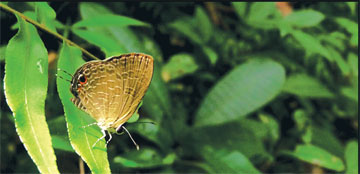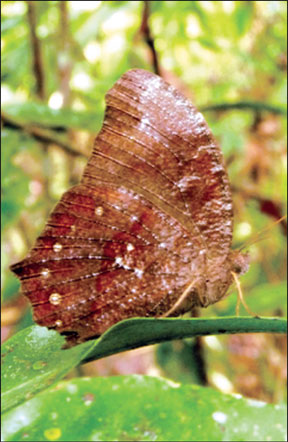The complexities of being a butterfly
Kshanika Goonesekera
 The simplest organism is most often the most stable in this world of
ever changing environments. Call it climate change, global warming or
just another natural phenomenon, we as complex organisms are the most
unyielding creatures and find these changes intolerable and terrifying.
Try as we might to adapt, so far we have been quite unsuccessful but
never let it be known that we do not make every effort to comply with
nature's commands. Sometimes it is to stubbornly ignore the information
around us but never-the-less we observe and diligently record everything
that transpires. The simplest organism is most often the most stable in this world of
ever changing environments. Call it climate change, global warming or
just another natural phenomenon, we as complex organisms are the most
unyielding creatures and find these changes intolerable and terrifying.
Try as we might to adapt, so far we have been quite unsuccessful but
never let it be known that we do not make every effort to comply with
nature's commands. Sometimes it is to stubbornly ignore the information
around us but never-the-less we observe and diligently record everything
that transpires.
|

Ceylon birdwing |
Butterflies have followed us through myths/legends and have been
recognized as ambassadors of nature. Pollinators, indicators of
pollution, there are a remarkable diversity of species found throughout
the world. Until recently our island was thought to boast 243 species
which today, as stated in the 2012 National Red List, has risen to 245
species with 26 of them being endemic. We possess species from all five
butterfly families within the super family Papilionoidae as well as
super family Hesperoidae previously not considered true butterflies.
Hesperiidae, Lycaenidae and Satyrinae
Their magnificent colours, large and small, have no doubt been
captured by many a camera may it be during a holiday expedition or in
the privacy of your back garden; but what of them? What do we actually
know about butterflies except that they are one of the prettiest
insects?
|

Common Evening Brown |
A research project is underway in an endeavour to investigate the
seasonal variation observed as dry and wet seasonal forms among three
genera of local butterflies categorized to the families Hesperiidae,
Lycaenidae and sub-family Satyrinae. The projected aided by the National
Research Council, Sri Lanka (NRC) involves a search for eleven species
of butterflies throughout the island in order to have a comprehensive
look at the morphological variations reported by past naturalists and
lepidopterists both local and foreign. The data gathered will aid a
genetic analysis performed to determine such attributes as evolutionary
patterns, radiation and diversification, taxanomic status etc.
|

Plum Judy
Common Evening Brown
Pictures courtesy Nadya Tissera & Ursula Gonsalves |
Many international studies have been conducted on similar lines
mostly on the sub-family Satyrinae, where the seasonal variations have
been scrutinized going as far as to analyze their evolutionary history
and geographic radiations. The species included in these studies, though
present in Sri Lanka with several endemics, were from India, Bangladesh,
Laos, Thailand and Indonesia extending to Australia excluding Sri Lanka!
Such an investigation of local populations in relation to their
international counterparts would have enlightened our scientists on many
vital avenues of research. It is a pity that we and our bounty of
diverse species are regularly excluded thus, partly due to the stringent
laws governing the protection of our flora and fauna from miscreants but
also party because we lack the molecular data international studies
require.
To be continued |





